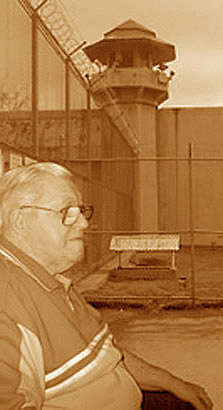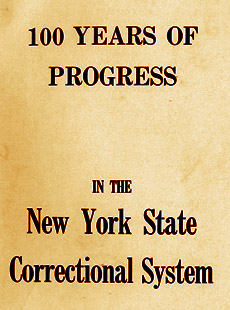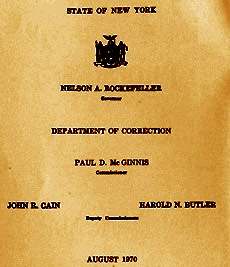

 |
The August 1970 booklet text, Pages 1 through 8: The 100th annual national Congress of Correction in
Cincinnati in 1970 will be devoted to the centennial celebration of
that event and will feature an exhibit depicting a century of
progress in the treatment of offenders.
|  Outer & inner front cover. 
|
|
New York State is represented on the national committee
for that exhibit and its institutions will play a significant role
in the presentation.
The exhibit of the New York State Department of
Correction at this year's New York State Fair is designed to give
the citizens of this State an opportunity to view a graphic
demonstration of the vast strides that New York has taken
over the past 100 years to rehabilitate rather than to merely
punish those who have broken its laws.
Despite the shortcomings of the penal system of the mid-
19th century, which are so obvious to us as we view them
in retrospect, New York State was a leader even in those days.
A century ago reformers were at work gradually introducing
the emphasis on rehabilitation which was to mark the
establishment a few years later of Elmira Reformatory, and the
growth of the whole system of "reformatories" and
"correctional institutions."
New York remains a leader and pioneer today in the field
of correctional treatment. It is a field, however, in which the
programs change dramatically from year to year. Progress is
measured in months now, rather than in decades as it was a
century ago.
The New York State Fair exhibit can give you only a
glimpse of the progress that has been made, the variety of the
programs that now exist, and their implications for you and
the offender - - who will some day return to your community.
This small brochure can only highlight and contrast for
you the difference a century has made in a few of the principal
programs designed to prepare the offender for that day when
he leaves the institution. These include medical services and
health, education, counseling and casework, work, and food
services.
The past decade has been especially marked by broad
modifications, extensions and improvements of the State
correctional system, spearheaded by study groups and committees
established by Govenor Nelson A. Rockefeller, including the
Governorís Special Committee on Criminal Offenders, and by
measures passed by the Legislature, many on the
recommendations of these groups.
If you wish to learn more about these progressive and
changing programs, write for a copy of the 1969 Annual
Report to:
New York State Department of Correction In 1870, the State institutions for the confinement of offenders consisted of Auburn, Clinton and Sing Sing Prison, a "Female Prison" at Sing Sing and an "Asylum for Insane Convicts" at Auburn. The average number of convicts . . . then was: Sing Sing - 1,270; Auburn - 950; Clinton - 503; Females - 130; Asylum - 78; total - 2,931. The prison "system" was under the loose supervision of three elected "inspectors" who appointed the "agent and warden" to operate each prison. The appointments were admittedly "entirely political" and involved a continuous change of staff. At this period, each inspector usually spent three months at each of the three prisons, rotating each quarter.
One hundred years later in 1970, the Department of Correction is operating twenty-four highly diversified correctional facilities. They are no longer autonomus but are under the central control of the Main Office and are staffed under the Civil Service system. These correctional facilities include a reception center for the study and classification of young men 16 to 21 years of age, four conservation work camps for young men, an institution for the mentally retarded male offenders and one for mentally retarded female offenders, two hospitals for mentally ill offenders, six maximum security facilities for men and four medium security facilities for men, three female correctional facilities and two diagnostic and treatment centers.
If men died from Asiatic cholera in 1840 in Sing Sing, or suffered from scurvy and persistent dysenteries, so were they dying and sufferiing from these things outside the walls. If they were lighting their ha!ls with camphene in 1850 and running their factories with direct drives from steam engines in 1870, they were doing at the prison only what was customary . . . Until almost 1900 there were but two professional workers employed, the physician and the chaplain. The one physician operated the hospital with no assistant physician, no nurse , no pharmacist. If he was lucky enough, he could once in a while, have an inmate assigned from the population who had some training in medicine or pharmacology.
Medical treatment in the modern correctional institution, as in the community, plays a vital, day-to-day role. There are daily sick calls, attention to emergencies, regular hospital ward care, laboratory examinat!ons and procedures, major and minor surgery. Dental, optical and nursing services are routinely available. This medical care is provided by qualified personnel in modern facilities. There are over 150 full-time professional positions in the institutional medical service, not counting psychiat1ists. In addition, the various institutions regularly supplement these services through the use, on a part-time and case basis, of an extensive number of medical and surgical specialists, dentists, and professionals in the optical field. Where necessary, inmates are taken to outside community medical facilities for treatment or surgery. Inmates with major medical problems are frequently transferred to Ossining Correctional Facility which has the best equipped and staffed hospital and a highly diversified visiting and consulting staff. Inmates with cancer are transferred to Attica Correctional Facility in order to receive appropriate treatment at the renowed Roswell Park Memorial Institute. Specialized surgical and oral surgery programs are also available at Attica Correctional Facility for its inmates or for other offenders transferred there.
A four-year research-demonstration project partially funded by the federal government has been established at Attica Correctional Facility. Operating at the present time with close to 100 carefully selected inmates, it is designed to demonstrate the effectiveness of a vocational rehabilitation program for disabled adult male offenders confined at various correctional facilities. Based in a rehabilitation workshop in the institution, it is attempting to restore disabled offenders to productive roles, not only within the institution but, more importantly, in the community to which they inevitably return. A similar but smaller project (involving 24 inmates in the past year) has been in operation since 1965 for young male offenders under 21 years of age at the Coxsackie Correctional Facility.
The other of the two "professionals," the poor harassed lone chaplain, zealously attempted the work of a dozen departments and as many specialists. The spiritual needs of the population were but the beginning of his duties. He was adviser, social worker, librarian, educator, and not least of all, correspondence censor . . . . The first legislation governing [prison] education was passed in 1847, directing the employment of two part-time teachers who were to be under the supervision of the chaplain. They were to teach English in the evening to inmates who, in the opinion of the warden and chaplain, were able to profit from it. The teachers attempted to give such instruction on the galleries at night. With the inmate behind the heavy lattice of his cell and the teacher parked on the bleak gallery outside with his book and flickering light, a situation was presented hardly conducive to learning. At least it was a beginning, though the first chaplain had tried with the bible to teach men to read and write in 1828. Poor light, absence of an adequate supply of books, slates and pencils, as well as the inability to achieve any kind of group situation, mitigated against the accomplishment of very much. Teachers complained about these things especially the inadequate light, saying that men in the upper galleries in 1858, despite the improvements mentioned, were unable to read at all . . . . While the aims of the teachers were lofty, they continued to work for some years under these same conditions with even a greater paucity of educational materials, until the program petered out entirely some time before 1880, though the law governing the employment of teachers was still in effect until it was changed in 1905. There was no such instruction at least in the late 1870s and most of the 1880s . . . .
In a diversified department-wide educational program employing well over 300 professionally qualified teachers, instructors and supervisory personnel the Department provides a balanced program of academic instruction, vocational training, work experience, and recreational activities designed to prepare inmates to become contributing members of society upon their release. The academic programs, reaching more than 5,000 inmates a year, are designed for all levels of student work - literacy, remedial, elementary, secondary and college as well as for the persons of retarded, average and above-average intelligence. In recent years as many as 1,000 inmates per year have been enabled to secure high school equivalency diplomas while in confinement. Increasingly, the Department is utilizing the National Educational Television network and closed-circuit television to enhance and update the educational offerings. There has been a great expansion in almost all Facilities in the area of fine arts and hobby craft. This program provides an acceptable avenue of expression for the inmates, teaches the value of an individualís work and reveals latent talents. The institutions participate in many art exhibits throughout the year and the inmate artists realize considerable income from the sale of their woks, while at the same time the talented prepare themselves for remunerative post-release careers. In the field of vocational training, which was provided for some 7,000 inmates last year, the Department emphasizes trades that offer inmates the greatest opportunity for jobs upon release. Notable examples are the Dental Laboratory at Auburn Correctional Facility and the Optical Laboratory at Wallkill Correctional Facility. Not only do these new programs produce dentures and eye glasses for inmates at considerable saving to the State, but they also represent trades in which there are realistic opportunities for parolees to secure worthwhile employment.
|

|

|

|